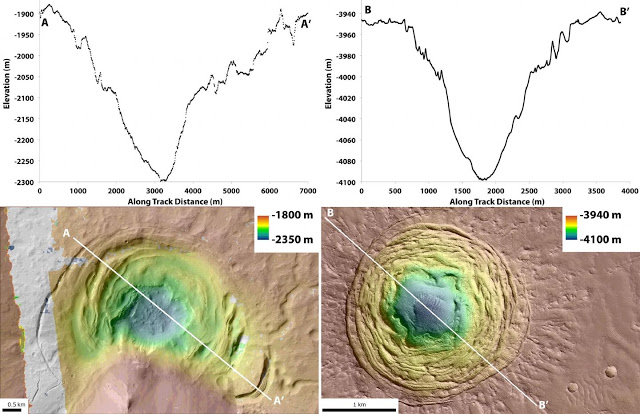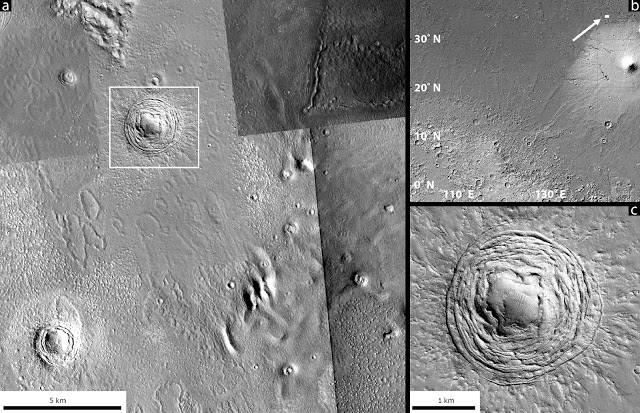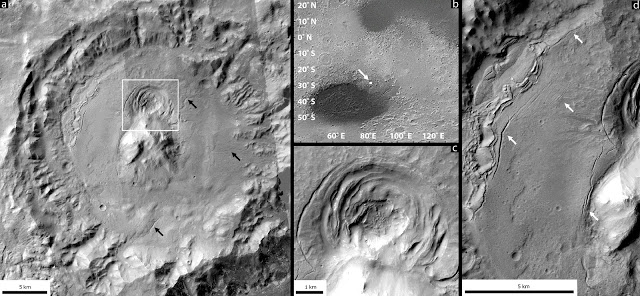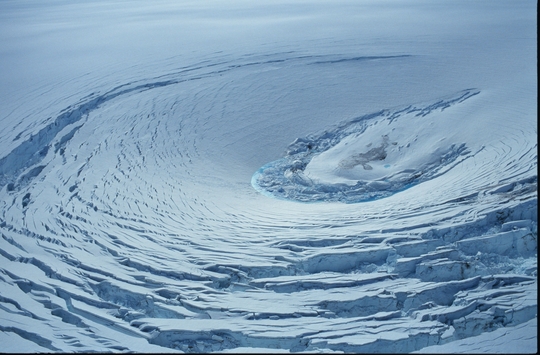

| Online: | |
| Visits: | |
| Stories: |

| Story Views | |
| Now: | |
| Last Hour: | |
| Last 24 Hours: | |
| Total: | |
Martian Funnel Could Support Alien Life
The findings were published this month in Icarus, the International Journal of Solar System Studies.
“We were drawn to this site because it looked like it could host some of the key ingredients for habitability — water, heat and nutrients,” said lead author Joseph Levy, a research associate at the University of Texas Institute for Geophysics, a research unit of the Jackson School of Geosciences.
(Left) A graph charting the depth of the Hellas depression at different points, and a topographic map of the depression. (Right) A graph charting the depth of the Galaxias Fossae depression at different points, and a topographic map of the depression.

Joseph Levy/NASA
“These landforms caught our eye because they’re weird looking. They’re concentrically fractured so they look like a bulls-eye. That can be a very diagnostic pattern you see in Earth materials,” said Levy, who was a postdoctoral researcher at Portland State University when he first saw the photos of the depressions.
But it wasn’t until this year that he and his research team were able to more thoroughly analyze the depressions using stereoscopic images to investigate whether the depressions were made by underground volcanic activity that melted away surface ice or by an impact from an asteroid. Study collaborator Timothy Goudge, a postdoctoral fellow at the institute, used pairs of high-resolution images to create digital elevation models of the depressions that enabled in-depth analysis of their shape and structure in 3-D. Researchers from Brown University and Mount Holyoke College also participated in the study.
A depression in the Galaxias Fossae region of Mars viewed from multiple perspectives. New research suggests that the depression was formed by an asteroid impact.
“The big contribution of the study was that we were able to measure not just their shape and appearance, but also how much material was lost to form the depressions. That 3-D view lets us test this idea of volcanic or impact,” Levy said.
The analysis revealed that both depressions shared an unusual funnel shape, with a broad perimeter that gradually narrowed with depth.
“That surprised us and led to a lot of thinking about whether it meant there was melting concentrated in the center that removed ice and allowed stuff to pour in from the sides. Or if you had an impact crater, did you start with a much smaller crater in the past, and by sublimating away ice, you’ve expanded the apparent size of the crater,” Levy said.
A depression located inside a crater on the edge of the Hellas basin region of Mars. New research suggests that the depression was formed by volcanic activity beneath an ice sheet—an environment that could be suitable for microbial life.
The interaction of lava and ice to form a depression would be an exciting find, Levy said, because it could create an environment with liquid water and chemical nutrients, both ingredients required for life on Earth. He said that the Hellas depression and, to a lesser extent, the Galaxias Fossae depression, should be kept in mind when looking for habitats on Mars.
Volcanic eruptions beneath ice can create surface formations called “ice cauldrons,” such as this one that formed in Iceland’s Vatnajökull ice cap. The research suggests that a strangely shaped depression on Mars could be an icice_cauldrone cauldron.
Gro Pedersen, a volcanologist at the University of Iceland who was not involved with the study, agrees that the depressions are promising sites for future research.
“These features do really resemble ice cauldrons known from Earth, and just from that perspective they should be of great interest,” Pedersen said. “Both because their existence may provide information on the properties of subsurface material — the potential existence of ice — and because of the potential for revealing ice-volcano interactions.”
The research was supported by a NASA Mars Data Analysis Program award.
Anton Caputo
Source:







WIKILEAKS UFO FILES BOOK Just released are all the amazing UFO and ALIEN secrets the government has been hiding behind Secret and higher classifications! You’ll soon discover why some government officials want Julian Assange dead, and I assume I won’t be too popular with the government either, now that I’m actually putting some of their most secret info into some many hands!
http://www.blue-planet-project.com/wikileaks-ufo-files.html